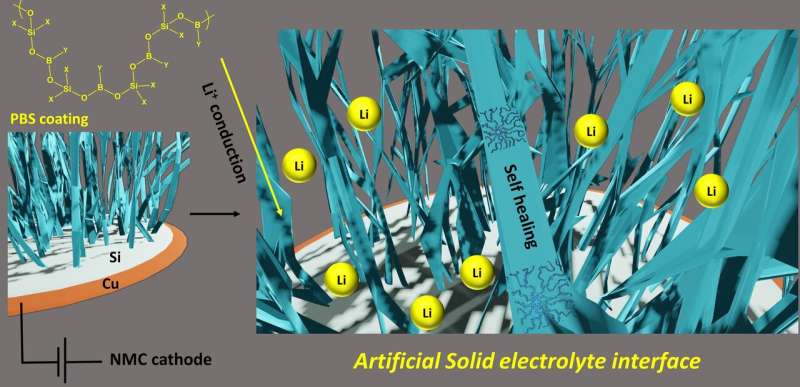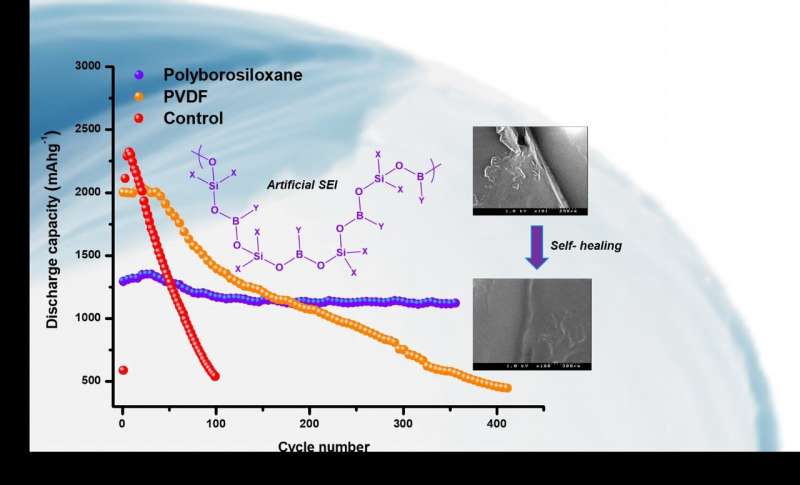Packing more juice in lithium-ion batteries through silicon anodes and polymeric coatings

Although silicon anodes could greatly boost the capacity of Li-ion batteries, their performance rapidly degrades with use. Polymeric coatings can help solve this problem, but very few studies have explored the underlying mechanisms. In a recent study, scientists from Japan Advanced Institute of Science and Technology investigate how a poly(borosiloxane) coating greatly stabilizes the capacity of silicon anodes, paving the way for better and more durable Li-ion batteries for electric cars and renewable energy harvesting.
Since their conception, lithium-ion batteries (LIBs) have been constantly improved and adapted so that they can become suitable for vastly different applications, from mobile devices and electric cars to storage units for renewable energy harvesters. In most larger-scale applications (such as the latter two), the focus of LIB research is placed on increasing their capacity and voltage limits without increasing their overall size. Of course, for that to be possible, the components and materials of the battery must be switched up.
Many researchers have placed their bets on the use of silicon anodes instead of the traditional graphite anodes. The anode is the part of the battery where lithium ions are stored when the battery is charged, which then flow through a medium called electrolyte to the cathode on the other end when the battery's charge is used. Although silicon is certainly a promising anode material that offers an almost tenfold capacity increase for LIBs, it brings with it a series of challenges that have to be overcome before silicone anodes can be commercialized.
In a recent study published in ACS Applied Energy Materials, a team of scientists from Japan Advanced Institute of Science and Technology (JAIST) tackled the problems of silicon anodes using a promising polymeric coating: poly(borosiloxane) (PBS). The study was led by Professor Noriyoshi Matsumi and also involved Dr. Sai Gourang Patnaik and Dr. Tejkiran Pindi Jayakumar, who were completing a doctoral course at JAIST at the time.

Polymeric coatings can solve one of the most serious drawbacks plaguing silicon anodes: the formation of an excessively large solid electrolyte interphase (SEI). The spontaneous formation of the SEI between the electrolyte and the anode is actually essential for the long-term performance of the battery. However, materials like silicon tend to expand greatly with use, which causes continuous SEI formation and the depletion of the available electrolyte. Needless to say, this hinders the performance of the battery and causes a massive drop in capacity over time.
This is where polymeric coatings come into play; they can prevent the excessive SEI formation on silicon and form an artificial and stable SEI (see Figure 1). Though researchers had already noted the potential of PBS as a coating for silicon anodes, previous studies did not offer clear explanations for the mechanisms at play, as Prof. Matsumi explains, "There are very few reports on well-defined PBS-based polymers that offer a mechanistic origin for their application and their effects. Thus, we wanted to evaluate and shed light on their contribution to silicon anodes as a self-healing artificial interface that also prevents detrimental volume expansion."
The team compared the short- and long-term performance of silicon anodes with and without polymeric coatings in terms of stability, capacity, and interfacial properties. They did this through a series of electrochemical measurements and theoretical calculations, which led them to understand how PBS helps stabilize the capacity of the silicon anode.
Compared to bare silicon anodes and anodes coated with poly(vinylidene fluoride) (a commercially used coating in LIBs), the self-healing properties of PBS and its reversible accommodation of lithium ions resulted in remarkably enhanced stability. This is partially due to the ability of PBS to fill in any cracks formed in the SEI during operation. As shown in Figure 2, the capacity of the PBS-coated silicon anode remained almost the same for over 300 hundred cycles, unlike that of the other two anodes.
By addressing the main issues associated with silicon anodes, this study paves the way to a new generation of LIBs with much higher capacity and durability. Satisfied with the results, Prof. Matsumi remarks, "The widespread adoption of high-capacity LIBs will allow electric cars reach longer distances, drones become larger, and renewable energy be stored more efficiently." He also adds that, within a decade, we might even see LIBs used as secondary energy sources in larger vehicles such as trains, ships, and aircrafts. Let us hope further research gets us there!
More information: Sai Gourang Patnaik et al, Defined Poly(borosiloxane) as an Artificial Solid Electrolyte Interphase Layer for Thin-Film Silicon Anodes, ACS Applied Energy Materials (2021). DOI: 10.1021/acsaem.0c02749

















